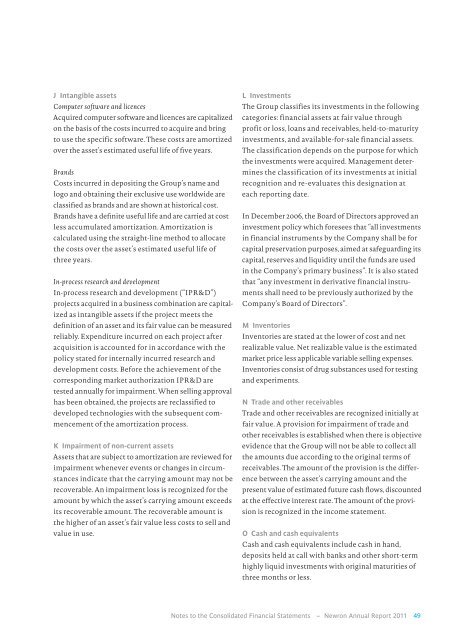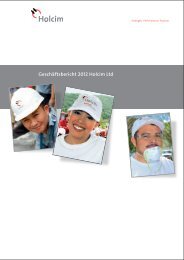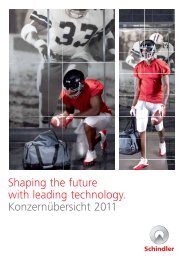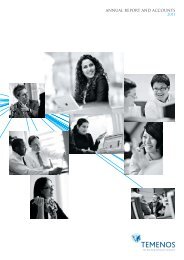download PDF - Newron
download PDF - Newron
download PDF - Newron
Create successful ePaper yourself
Turn your PDF publications into a flip-book with our unique Google optimized e-Paper software.
J Intangible assets<br />
Computer software and licences<br />
Acquired computer software and licences are capitalized<br />
on the basis of the costs incurred to acquire and bring<br />
to use the specific software. These costs are amortized<br />
over the asset’s estimated useful life of five years.<br />
Brands<br />
Costs incurred in depositing the Group’s name and<br />
logo and obtaining their exclusive use worldwide are<br />
classified as brands and are shown at historical cost.<br />
Brands have a definite useful life and are carried at cost<br />
less accumulated amortization. Amortization is<br />
calculated using the straight-line method to allocate<br />
the costs over the asset’s estimated useful life of<br />
three years.<br />
In-process research and development<br />
In-process research and development (“IPR&D”)<br />
projects acquired in a business combination are capitalized<br />
as intangible assets if the project meets the<br />
defin ition of an asset and its fair value can be measured<br />
reliably. Expenditure incurred on each project after<br />
acquisition is accounted for in accordance with the<br />
policy stated for internally incurred research and<br />
development costs. Before the achievement of the<br />
corresponding market authorization IPR&D are<br />
tested annually for impairment. When selling approval<br />
has been obtained, the projects are reclassified to<br />
developed technologies with the subsequent commencement<br />
of the amortization process.<br />
K Impairment of non-current assets<br />
Assets that are subject to amortization are reviewed for<br />
impairment whenever events or changes in circumstances<br />
indicate that the carrying amount may not be<br />
recoverable. An impairment loss is recognized for the<br />
amount by which the asset’s carrying amount exceeds<br />
its recoverable amount. The recoverable amount is<br />
the higher of an asset’s fair value less costs to sell and<br />
value in use.<br />
L Investments<br />
The Group classifies its investments in the following<br />
categories: financial assets at fair value through<br />
profit or loss, loans and receivables, held-to-maturity<br />
investments, and available-for-sale financial assets.<br />
The classification depends on the purpose for which<br />
the investments were acquired. Management determines<br />
the classification of its investments at initial<br />
recognition and re-evaluates this designation at<br />
each reporting date.<br />
In December 2006, the Board of Directors approved an<br />
investment policy which foresees that “all investments<br />
in financial instruments by the Company shall be for<br />
capital preservation purposes, aimed at safeguarding its<br />
capital, reserves and liquidity until the funds are used<br />
in the Company’s primary business”. It is also stated<br />
that “any investment in derivative financial instruments<br />
shall need to be previously authorized by the<br />
Company’s Board of Directors”.<br />
M Inventories<br />
Inventories are stated at the lower of cost and net<br />
realizable value. Net realizable value is the estimated<br />
market price less applicable variable selling expenses.<br />
Inventories consist of drug substances used for testing<br />
and experiments.<br />
N Trade and other receivables<br />
Trade and other receivables are recognized initially at<br />
fair value. A provision for impairment of trade and<br />
other receivables is established when there is objective<br />
evidence that the Group will not be able to collect all<br />
the amounts due according to the original terms of<br />
receivables. The amount of the provision is the difference<br />
between the asset’s carrying amount and the<br />
present value of estimated future cash flows, discounted<br />
at the effective interest rate. The amount of the provision<br />
is recognized in the income statement.<br />
O Cash and cash equivalents<br />
Cash and cash equivalents include cash in hand,<br />
deposits held at call with banks and other short-term<br />
highly liquid investments with original maturities of<br />
three months or less.<br />
Notes to the Consolidated Financial Statements – <strong>Newron</strong> Annual Report 2011 4 9

















